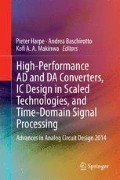Abstract
Analysis of recent publications reveals that high performance DAC design can be sub-divided into two types of design approaches. In essence these approaches differ as far as the control of mismatch related effects is concerned. On the one hand one can design such that these effects are intrinsically sufficiently under control but then additional advanced design techniques are required to limit the side-effects of this intrinsic approach. On the other hand one can also rely on mismatch calibration to simplify the design itself. For this approach we will also focus on a more recent specific calibration concept for high performance DACs to unify 16-bit dynamic range with GS/s data-rates. Both approaches have their strengths and weaknesses and depending on the application either one could be more favorable.
Access this chapter
Tax calculation will be finalised at checkout
Purchases are for personal use only
References
W. Schofield, D. Mercer & L. St. Onge, “A 16 b 400 MS/s DAC with <−80 dBc IMD to 300 MHz and < −160dBm/Hz Noise Power Spectral Density”, IEEE, ISSCC Dig. Tech. Papers, pp. 126–127, Feb. 2003.
H. Van de Vel et al., “A 240 mW 16 b 3.2 GS/s DAC in 65 nm CMOS with <−80 dBc IM3 up to 600 MHz”, IEEE, ISSCC Dig. Tech. Papers, pp. 206–207, Feb. 2014.
G. Engel, S. Kuo & S. Rose, “A 14 b 3/6 GS/s Current-Steering RF DAC in 0.18 um CMOS with 66 dB ACLR at 2.9 GHz”, IEEE, ISSCC Dig. Tech. Papers, pp. 458–459, Feb. 2012.
C-H. Lin et al., “A 12 b 2.9 GS/s DAC with IM3 <−60 dBc beyond 1 GHz in 65 nm CMOS”, IEEE, ISSCC Dig. Tech. Papers, pp. 74–75, Feb. 2009.
G. Manganaro, “Advanced Data Converters”, Cambridge University Press, 2012.
S. Balasubramanian & W. Khalil, “Architectural trends in current-steering digital-to-analog converters”, Springer, Analog Integrated Circuits & Signal Processing, vol. 77, pp. 55–67, May 2013.
S. Park et al., “A Digital-to-Analog Converter Based on Differential-Quad Switching”, IEEE, J. of solid-state circuits, vol. 37, no. 10, pp. 1335–1338, Oct. 2002.
D. Mercer, “A Study Of Error Sources In Current Steering Digital-to-Analog Converters”, IEEE, CICC Dig. Tech. Papers, pp. 185–190, Oct. 2004.
M. Pelgrom, A. Duinmaijer & A. Welbers, “Matching Properties of MOS transistors”, IEEE, J. of solid-state circuits, vol. 24, no. 5, pp. 1433–1440, Oct. 1989.
K. Doris, A. van Roermund & D. Leenaerts, “Wide-Bandwidth High Dynamic Range D/A Converters”, Springer, 2006.
Y. Tang, et al., “A 14 bit 200 MS/s DAC with SFDR > 78dBc, IM3 <−83 dBc and NSD <−163 dBm/Hz across the whole Nyquist band enabled by dynamic mismatch mapping”, IEEE, J. of solid-state circuits, vol. 46, no. 6, pp. 1371–1381, June 2011.
J. Briaire, “Error reduction in a digital-to-analog (DAC) converter”, US patent 7394414, April 2005.
Author information
Authors and Affiliations
Corresponding author
Editor information
Editors and Affiliations
Rights and permissions
Copyright information
© 2015 Springer International Publishing Switzerland
About this chapter
Cite this chapter
Briaire, J. et al. (2015). High-Performance DACs: Unifying 16-Bit Dynamic Range with GS/s Data-Rates. In: Harpe, P., Baschirotto, A., Makinwa, K. (eds) High-Performance AD and DA Converters, IC Design in Scaled Technologies, and Time-Domain Signal Processing. Springer, Cham. https://doi.org/10.1007/978-3-319-07938-7_6
Download citation
DOI: https://doi.org/10.1007/978-3-319-07938-7_6
Published:
Publisher Name: Springer, Cham
Print ISBN: 978-3-319-07937-0
Online ISBN: 978-3-319-07938-7
eBook Packages: EngineeringEngineering (R0)

